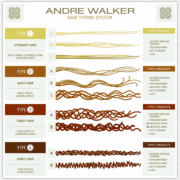FIA Hair Typing For Identifying Your Tresses
Of all the hair typing systems in use today, there’s one thing they all have in common. Four broad categories of curl pattern:
- straight
- wavy
- curly, and
- very curly or coily, also called kinky.
There are three mainstream classification systems:
- the Andre Walker hair typing system
- the LOIS hair typing system, and
- the FIA hair typing system.
According to auntlucysfolksense.wordpress.com the FIA system is the most used worldwide.
The best of both worlds
At first glance, the FIA Hair Typing System has similar categories to the Andre Walker system but then includes individual testing, like the L.O.I.S., for an enhanced hair profile diagnosis. But let’s start at the beginning.
FIA has 4 levels of hair texture, which are differentiated with a numbered system like Walker’s:
The straight ones:
- 1a – stick straight, absent of curl
- 1b – straight but with a slight body wave, just enough to add some volume, doesn’t look wavy
- 1c – straight with body wave and one or two visible S-waves (e.g. nape of neck or temples)
The wavy ones:
- 2a – loose, stretched out S-waves throughout the hair
- 2b – shorter, more distinct S-waves (similar to waves from braiding damp hair)
- 2c – distinct S-waves and the odd spiral curl forming here and there
The curly ones:
- 3a – big, loose spiral curls
- 3b – bouncy ringlets
- 3c – tight corkscrews (This category does not exist in the Andre Walker system.)
The really curly ones:
- 4a – tightly coiled S-curls
- 4b – tightly coiled hair bending in sharp angles (Z-pattern)
Having numbers allows you to get really specific about your hair classification.
Understanding your hair today to get the hair you want tomorrow.
Like the L.O.I.S., FIA goes beyond the broad classification to look further into your specific hair qualities.
Rather than defining your hair as a whole, FIA introduces texture identification by examining individual strands. Take the time to determine whether it’s fine, medium or coarse in nature:
- Fine hair strands appear almost translucent when held up to the light. They can be hard to see even when up against a contrasting background.
- Medium hair strands are your average consistency. If you roll it between your thumb and index finger, it will feel a little like cotton thread but isn’t stiff or rough.
- Coarse hair strands are usually easy to identify against most backgrounds. When rolling this type of hair between your thumb and index finger, it will feel hard and wiry.
For an alternative way to determine texture, try this water test at science-yhairblog.blogspot.ca.
Hair texture will dictate the types of products you need to get your hair to behave the way you want it to.
Less is less and more is more.
The final component of the FIA system is the overall volume of your hair. The prescribed ponytail test measures the circumference, or distance around the shaft of a dry hair ponytail, to determine hair volume. There are two factors at play here, strand thickness and density of scalp coverage.
Because they are measured together, you don’t have individual data for each of the components. FIA may assume that you take note of the hair thickness at the same time that you are measuring for texture, but it’s not specifically mentioned in the material referenced.
- Thin has a circumference of less than 2 in or 5 cm
- Medium or Normal has a circumference between 2 to 4 in or 5 to 10 cm
- Thick has a circumference of more than 4 in or 10 cm
The thing I like about the FIA system is that it takes a few more hair characteristics into account for a better overall hair type diagnosis.
How does it measure up?
We put together this chart to show you a side by side comparison of the three most recognized systems. Just in case you were wondering whether one was more accurate than another.

If FIA is the system for you, go ahead and assess your hair and retake your control. Knowledge is power.






Leave a Reply
Want to join the discussion?Feel free to contribute!